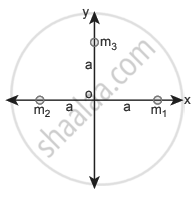Advertisements
Advertisements
Question
A planet moving along an elliptical orbit is closest to the Sun at distance r1 and farthest away at a distance of r2. If v1 and v2 are linear speeds at these points respectively. Then the ratio `"v"_1/"v"_2` is
Options
`"r"_2/"r"_1`
`("r"_2/"r"_1)^2`
`"r"_1/"r"_2`
`("r"_1/"r"_2)^2`
Solution
`"r"_2/"r"_1`
APPEARS IN
RELATED QUESTIONS
The gravitational potential energy of the Moon with respect to Earth is ____________.
The work done by the Sun’s gravitational force on the Earth is __________.
The magnitude of the Sun’s gravitational field as experienced by Earth is
An object of mass 10 kg is hanging on a spring scale which is attached to the roof of a lift. If the lift is in free fall, the reading in the spring scale is ___________.
Define gravitational potential energy.
If a comet suddenly hits the Moon and imparts energy which is more than the total energy of the Moon, what will happen?
If the Earth’s pull on the Moon suddenly disappears, what will happen to the Moon?
If the ratio of the orbital distance of two planets `"d"_1/"d"_2` = 2, what is the ratio of gravitational field experienced by these two planets?
Calculate the gravitational field at point O due to three masses m1, m2 and m3 whose positions are given by the following figure. If the masses m1 and m2 are equal what is the change in a gravitational field at the point O?

What is the gravitational potential energy of the Earth and Sun? The Earth to Sun distance is around 150 million km. The mass of the Earth is 5.9 × 1024 kg and the mass of the Sun is 1.9 × 1030 kg.
